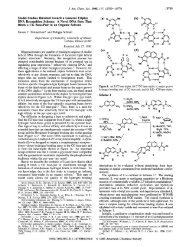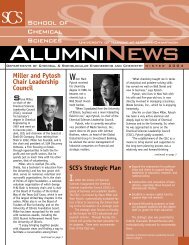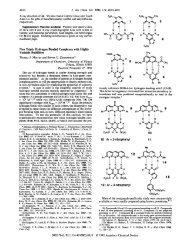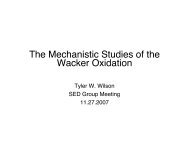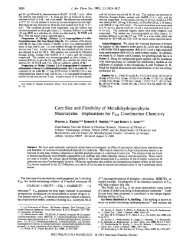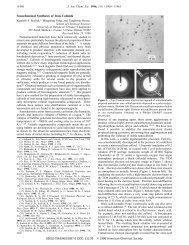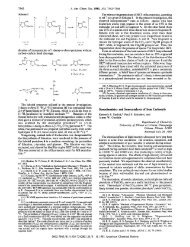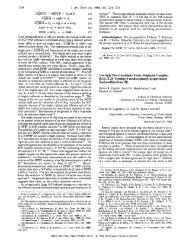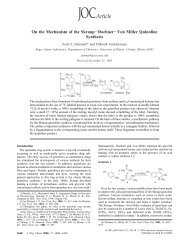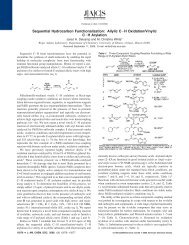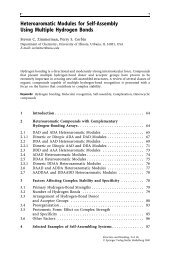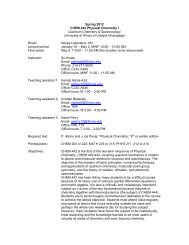FRIEDLIEB RUNGE AND HIS CAPILLARY DESIGNS
FRIEDLIEB RUNGE AND HIS CAPILLARY DESIGNS
FRIEDLIEB RUNGE AND HIS CAPILLARY DESIGNS
You also want an ePaper? Increase the reach of your titles
YUMPU automatically turns print PDFs into web optimized ePapers that Google loves.
Bull. Hist. Chem., VOLUME 30, Number 1 (2005) 31<br />
Wrozlaw, Poland) (4) in<br />
1828.<br />
Because he found<br />
the meager salary of a<br />
professor disappointing,<br />
Runge took a position in<br />
1833 at the Chemische<br />
Produktenfabrik in<br />
Oranienburg (5), where<br />
he sought the opportunity<br />
to bring his creativity and<br />
inventiveness to fruition.<br />
As technical director,<br />
Runge had as one of his<br />
assignments finding uses<br />
for coal tar oil, a<br />
byproduct in the manufacture<br />
of illuminating<br />
gas (6). In the process he<br />
discovered and identified<br />
phenol and aniline (7).<br />
Much to his surprise, he<br />
was able to isolate deepred<br />
crystals from the distillation<br />
residue. This<br />
Rosolsäure yielded a brilliant<br />
red dyestuff, the first<br />
synthetic textile colorant,<br />
suitable for dyeing calico and silk fabrics. Further investigations<br />
led Runge to the preparation of violet and<br />
bluedyestuffs. When cotton fibers were impregnated<br />
with aniline and then treated with copper salts and potassium<br />
chromate, there appeared a light-fast black,<br />
which could be reduced with sulfurous acid to an emerald<br />
green.<br />
Title page, Musterbilder für Freunde des Schönen,<br />
Berlin, 1850.<br />
Table. Examples of “Runge Designs”<br />
Runge informed his supervisors<br />
of his discoveries and<br />
proposed building a factory in<br />
Oranienburg for the manufacture<br />
of synthetic dyes and other<br />
coal tar products. This took<br />
place in 1836, indeed 20 years<br />
before the discovery of mauve<br />
(8) by W. Perkin (1856). His<br />
plan fell on deaf ears at general<br />
management in Berlin. He<br />
turned to experimenting with<br />
stearin and paraffin (9) for the<br />
manufacture of candles for domestic<br />
illumination, but his<br />
proposal to build a candle factory<br />
was also denied. Finally,<br />
Runge made the suggestion to<br />
manufacture “synthetic guano”<br />
from bones and other slaughter<br />
house wastes for use in agriculture<br />
(10). His thought was<br />
that the deteriorating fertility of<br />
farmland would afford an opportunity<br />
for a thriving enterprise<br />
and high profits. Once<br />
again, however, his message<br />
went nowhere.<br />
Runge was bitterly disappointed over the denial of<br />
his proposals and the continual disagreements with<br />
higher authorities. He accused the ministerial offices<br />
of scientific ignorance. In response the executive officers<br />
faulted Runge for spending too little time in the factory.<br />
In fact, Runge wrote no fewer than seven textbooks<br />
(11) during his employment, between 1834 and<br />
Solution A “Instrusion Agent” Solution B Result<br />
Pb(III) sulfate — K ferrocyanide deep-blue ring with<br />
brown border<br />
Mn sulfate ammonia K chromate dark brown ring with<br />
light brown border<br />
Cu sulfate (NH 4 )H 2 PO 4 K ferrocyanide red core with green<br />
border



